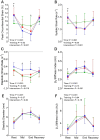Resistance- and endurance-trained young men display comparable carotid artery strain parameters that are superior to untrained men
- PMID: 39361034
- PMCID: PMC11753328
- DOI: 10.1007/s00421-024-05598-w
Resistance- and endurance-trained young men display comparable carotid artery strain parameters that are superior to untrained men
Abstract
Purpose: Central arterial stiffness, a predictor of cardiovascular risk, attenuates with endurance-exercise in ageing populations. However, in young individuals, this effect is inconsistent and emerging evidence suggests resistance-exercise may increase arterial stiffness. Two-dimensional (2D)-Strain imaging of the common carotid artery (CCA) is more sensitive at detecting endurance-training induced alterations in CCA stiffness than conventional methods, but has not been used to examine CCA stiffness in young resistance-trained individuals. Therefore, we compared CCA 2D-Strain parameters at rest, during acute exercise and recovery between resistance-trained, endurance-trained, and untrained young men.
Methods: Short-axis CCA ultrasound images were obtained from 12 endurance-trained [27yrs (95%CI; 24-29)], 14 resistance-trained [24yrs (23-26)] and 12 untrained [23yrs (22-24] men at rest, during isometric handgrip (IHG) exercise and recovery. 2D-Strain analysis quantified CCA peak circumferential strain (PCS) and systolic (S-SR) and diastolic (D-SR) strain rates. Conventional stiffness indices included aortic pulse-wave velocity, CCA β-stiffness (β1) and Petersons elastic modulus (Ep).
Results: Resting conventional stiffness indices were not different between groups (P > 0.05). Resting PCS and S-SR were comparable between resistance- [11.6% (10.6-12.5) and 1.46 s-1 (1.37-1.55), respectively] and endurance-trained [11.4% (10.7-12.2) and 1.5 s-1 (1.38-1.62)] men and superior to untrained men [9.5% (9.19-9.9); P < 0.004 and 1.24 s-1 (1.17 - 1.31); P < 0.018)]. Both trained groups displayed comparable reductions in PCS and S-SR during IHG, which returned to resting values during recovery (P < 0.001), whereas these parameters remained unchanged in untrained men. D-SR decreased during IHG in all groups (P < 0.001), but to a lesser extent in endurance-trained men (P < 0.023), whereas β1 and Ep increased to a similar magnitude in all groups and returned to resting values during recovery (P < 0.001).
Conclusion: Resistance- and endurance-trained men display comparable CCA 2D-Strain parameters that are superior to untrained men, which contends previous reports that resistance-training increases CCA stiffness.
Keywords: Arterial health; Carotid artery stiffness; Endurance-exercise; Resistance-exercise; Two-dimensional strain imaging.
© 2024. The Author(s).
Conflict of interest statement
Declarations. Conflict of interest: No conflicts of interest, financial or otherwise, are declared by the authors.
Figures


Similar articles
-
The influence of habitual endurance exercise on carotid artery strain and strain rate in young and middle-aged men.Exp Physiol. 2020 Aug;105(8):1396-1407. doi: 10.1113/EP088384. Epub 2020 Jul 8. Exp Physiol. 2020. PMID: 32578897
-
Carotid artery wall mechanics in young males with high cardiorespiratory fitness.Exp Physiol. 2018 Sep;103(9):1277-1286. doi: 10.1113/EP087067. Epub 2018 Aug 1. Exp Physiol. 2018. PMID: 29959801
-
The effect of an acute bout of resistance exercise on carotid artery strain and strain rate.Physiol Rep. 2016 Sep;4(17):e12959. doi: 10.14814/phy2.12959. Physiol Rep. 2016. PMID: 27624687 Free PMC article.
-
Vascular endothelium-derived factors and arterial stiffness in strength- and endurance-trained men.Am J Physiol Heart Circ Physiol. 2007 Feb;292(2):H786-91. doi: 10.1152/ajpheart.00678.2006. Epub 2006 Sep 22. Am J Physiol Heart Circ Physiol. 2007. PMID: 16997889
-
Comparison of arterial stiffness/compliance in the ascending aorta and common carotid artery in healthy subjects and its impact on left ventricular structure and function.Int J Cardiovasc Imaging. 2017 Apr;33(4):521-531. doi: 10.1007/s10554-016-1032-8. Epub 2016 Nov 24. Int J Cardiovasc Imaging. 2017. PMID: 27885494
References
-
- Baechle TR, Earle RW (2008) National strength and conditioning association (U.S.). Essentials of strength training and conditioning. Human Kinetics, Champaign
-
- Bjallmark A, Lind B, Peolsson M, Shahgaldi K, Brodin LA, Nowak J (2010) Ultrasonographic strain imaging is superior to conventional non-invasive measures of vascular stiffness in the detection of age-dependent differences in the mechanical properties of the common carotid artery. Eur J Echocardigr 11(7):630–636. 10.1093/ejechocard/jeq033 - PubMed
-
- Black JM, Stöhr EJ, Shave R, Esformes JI (2016a) Influence of exercise training mode on arterial diameter: a systematic review and meta-analysis. J Sci Med Sport 19(1):74–80. 10.1016/j.jsams.2014.12.007 - PubMed
-
- Bull FC, Al-Ansari SS, Biddle S, Borodulin K, Buman M, Cardon G, Carty C, Chaput JPCS, Chou R, Dempsey PC, DiPietro L, Ekelund U, Firth J, Friedenreich CM, Garcia L, Gichu M, Jago R, Katzmarzyk LE, Leitzmann M, Milton K, Ortega FB, Ranasinghe C, Stamatakis E, Tiedemann A, Troiano RP, van der Ploeg HP, Wari V, Willumsen JF (2020) World Health Organization 2020 guidelines on physical activity and sedentary behaviour. Brit J Sport Med 54(24):1451–1462. 10.1136/bjsports-2020-102955 - PMC - PubMed
MeSH terms
LinkOut - more resources
Full Text Sources
Research Materials

